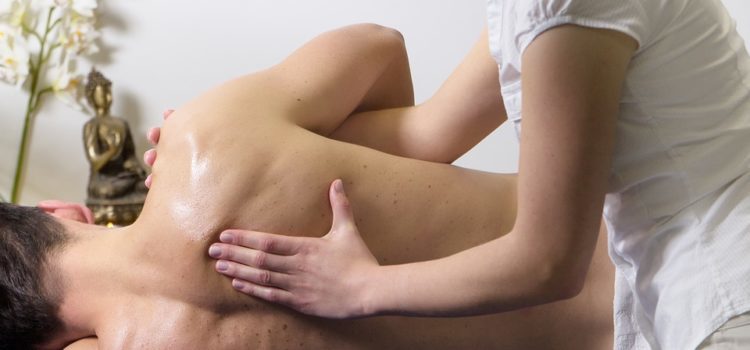 News, Newspaper
News, Newspaper
Massage therapy and shoulder pathologies
Shoulder pain is a frequently cited as the motive for a medical consultation. And for good reason: the shoulder joint is involved in nearly half of musculo-skeletal disorders affecting the upper limbs. How can massage therapy help?
The shoulder is a complex structure. Composed of muscles, tendons and bone, it lends the arm its mobility. Thanks to the shoulder joint, we can reach for a plate on the top shelf of a cupboard, pick up a child, and drive a car. In short, the shoulder is highly useful in our daily lives.
Several pathologies, same pain
When one of the structures in the shoulder is injured or doesn’t function properly, an inflammation or premature wear and tear can occur. And when it does, even the smallest everyday gestures can become a challenge due to the pain they cause.
Shoulder pathologies most often affect the part of the shoulder called the rotator cuff. This structure contains a group of muscles attached to the scapula on one side and the humerus on the other. The rotator cuff’s role is to ensure mobility and stability in the joint.
The following shoulder pathologies are among the most frequent:
- Tendinopathies*include all the pathologies that affect the tendon, the best-known being tendonitis. Tendinopathies occur when the tendon is unable to move freely within the joint, thereby causing inflammation, which in turn causes pain and stiffness in the shoulder. In the case of tendonitis, the pain tends to worsen with movement and decrease at rest.
- Bursitis*is provoked by an inflammation of the bursa sac, a joint structure that acts as a cushion when the tendons move over the bones. The pain associated with bursitis can be intense and often persists even at rest.
- Capsulopathies*include all the pathologies affecting the joint capsule. In the shoulder, the most frequent form of capsulopathy is adhesive capsulitis (frozen shoulder). This pathology is characterized by increased pain at rest.
- Luxation*,commonly referred to as a dislocation, occurs when the bones are displaced from the joint. A luxation causes pain, together with an inability to move the shoulder.
*Tendinopathies, bursitis, capsulopathies and luxations are not limited to the shoulder, but can also occur in other joints within the body.
Benefits of massage therapy for shoulder pathologies*
Adapted massage therapy, in addition to promoting well-being and relaxation, is proven to relax the muscle while improving joint mobility. It also helps ease pain in the shoulder.
The potential benefits associated with massage therapy also include improved range of movement, along with enhanced blood and lymph circulation, which helps promote recovery from a shoulder injury [1][2].
It is worth noting that all massage therapy techniques and approaches can be adapted in the presence of a shoulder pathology. Good examples include TragerMC, kinesitherapy, fascia therapy and shiatsu.
*Massage therapy is meant to serve as a complementary therapy, which can help relieve the symptoms of a number of health conditions, including shoulder pathologies, if adapted to an individual’s medical condition and administered by a competent, well-trained massage therapist. As part of a multidisciplinary approach, it should be provided in conjunction with other health disciplines (medicine, nursing science, physiotherapy, chiropractic, etc.).
What the research says
A few studies tend to bear out massage therapy’s effectiveness in treating people with shoulder pathologies:
- Researchers at Kangwon National University in South Korea looked at the impact of massage on improving the range of motion in the shoulder [2]. They carried out a systematic review and a meta-analysis, concluding that joint mobility improved following massages that featured effleurages, petrissages and friction. Specifically, massage helped to break down scar tissue and adhesions in the joint.
- The results of a meta-analysis published in 2013 showed that massage therapy was more effective in relieving shoulder pain than the absence of treatment, and just as effective as active treatment (e.g. acupuncture)[1].
Strategies complementary to massage for people with shoulder pathologies
- Limit repetitive movements.Repetitive movements, particularly those that involve lifting the hands above shoulder level, place considerable strain on the joint, which can provoke the onset of tendonitis and bursitis.
- Adopt proper posture.Ideally, the head, shoulders and pelvis should be properly aligned at all times. When that is not the case, the rotator cuff and other structures in the shoulder must compensate by working harder, which can lead to injury.
- Adapt your working position.If you’re among those who work at a computer all day long, it’s very important to adjust the position of your workstation in order to prevent injury. Chair height, the distance between the body and the keyboard, and head angle are just a few of the factors to take into consideration. If required, do not hesitate to consult an occupational therapist for assistance. And don’t forget to get up and move at regular intervals throughout the day in order to prevent stiffness!
To find out more
- Massage techniques
- Find a massage therapist
[1] Kong, L. J. et coll. (2013). Massage therapy for neck and shoulder pain: A systematic review and meta-analysis. Evidence-Based Complementary and Alternative Medicine, 13: Article ID: 613279, 10 pages.
[2] Yeun, Y.-R. (2017). Effectiveness of massage therapy on the range of motion of the shoulder: a systematic review and meta-analysis. Journal of Physical Therapy Science, 29:365-369.




